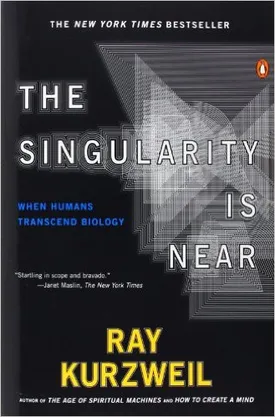The Singularity Is Near: When Humans Transcend Biology by Ray Kurzweil
Ray Kurzweil’s book “The Singularity Is Near: When Humans Transcend Biology” envisioned a future where technological advancements allow humanity to surpass the limitations of biology. Kurzweil predicts that the accelerating pace of technological development will lead to an era in which “our most fundamental ideas about what it means to be human” will be transformed.
Kurzweil identifies three key concepts as driving forces for this coming Singularity: evolutionary development, which drives humanity towards higher complexity; exponential growth, where technological advancement accelerates exponentially; and the evolutionary synthesis of biology and technology. He further claims that the rate of technological change is increasing so quickly that it is fast outpacing our ability to comprehend it, speculating that “in the twenty-first century, the rate of change could accelerate so dramatically that we may have difficulty in keeping track of it.”
Kurzweil makes predictions as to how these concepts will play out. He imagines a world in which computers possess greater than human intelligence, where “self-replicating nanobots” can manufacture whatever we wish and “nanomaterials” are used to create anything from “clothes and toys to buildings and vehicles.” Furthermore, he claims that virtual reality could become indistinguishable from physical reality, while “intelligent agents” – computers or robots with AI – may be used to do everyday tasks in our homes. He also postulates that “networked human brains” will someday be linked in cyberspace, creating a global consciousness.
Kurzweil’s book provides an analysis of the ethical and philosophical implications of a future in which biology and technology are intertwined. He argues that, with the advent of nanotechnology, many of the current ethical and philosophical issues regarding medical technology and biotechnology will disappear, and that radical life-extension technologies may become possible. In addition, he posits the idea that intelligence can be non-biological, that robots may be consciously aware, and that “soul transfer” – the process of moving one’s consciousness from a physical body to a non-physical entity – may one day be possible.
Although some may view Kurzweil’s predictions as far-fetched, the author offers a balanced assessment of the risks and rewards involved in a post-biological world. Kurzweil admits that the development of artificial intelligence could have potentially destructive outcomes, yet he emphasizes the potential benefits that may be obtained—including longer lifespans, increased memory capacity and better psychological and physical health.
Ultimately, Kurzweil’s book makes a compelling case for a future that is both exciting and terrifying. In addition to the ethical implications, he raises many questions about the far-reaching implications of technological development. It is an inspiring yet sobering look at the potential of the Singularity and what it could mean for humanity.

